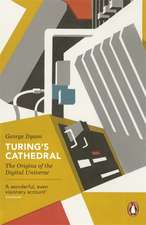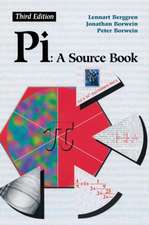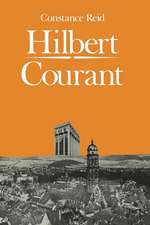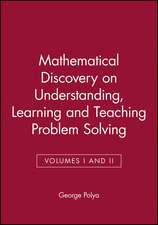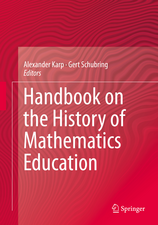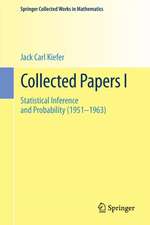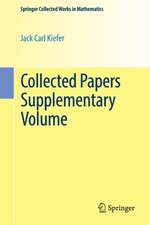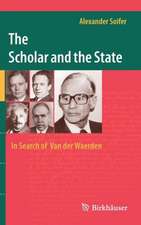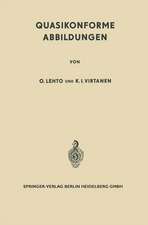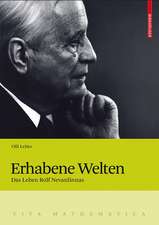Mathematics Without Borders: A History of the International Mathematical Union
Autor Olli Lehtoen Limba Engleză Hardback – 18 dec 1997
| Toate formatele și edițiile | Preț | Express |
|---|---|---|
| Paperback (1) | 220.83 lei 3-5 săpt. | |
| Springer – 29 sep 2012 | 220.83 lei 3-5 săpt. | |
| Hardback (1) | 320.87 lei 3-5 săpt. | |
| Springer – 18 dec 1997 | 320.87 lei 3-5 săpt. |
Preț: 320.87 lei
Nou
Puncte Express: 481
Preț estimativ în valută:
61.40€ • 65.66$ • 51.19£
61.40€ • 65.66$ • 51.19£
Carte disponibilă
Livrare economică 28 martie-11 aprilie
Preluare comenzi: 021 569.72.76
Specificații
ISBN-13: 9780387983585
ISBN-10: 0387983589
Pagini: 399
Ilustrații: XVI, 399 p.
Dimensiuni: 155 x 235 x 26 mm
Greutate: 0.77 kg
Ediția:1998
Editura: Springer
Colecția Springer
Locul publicării:New York, NY, United States
ISBN-10: 0387983589
Pagini: 399
Ilustrații: XVI, 399 p.
Dimensiuni: 155 x 235 x 26 mm
Greutate: 0.77 kg
Ediția:1998
Editura: Springer
Colecția Springer
Locul publicării:New York, NY, United States
Public țintă
Popular/generalDescriere
At its meeting in April 1990 at the University of Cambridge, the Executive Committee of the International Mathematical Union (IMU) decided that the largely unorganized archives of the Union should be properly arranged and catalogued. Simultaneously, the Executive Committee expressed the wish that a history of the Union should be written [1). As Secretary of the Union, I had proposed that these issues be dis cussed at the Cambridge meeting, but without having had in mind any personal role in the practical execution of such projects. At that time, the papers of the IMU were stored in Zurich, at the Eidgenossische Technische Hochschule, and I saw no reason why they could not remain there. At about this time, Professor K. Chandrasekharan produced a handwritten article titled "The Prehistory of the International Mathematical Union" [2), and it seemed to me that this might serve as the beginning of a more compre hensive history. I had first thought that Tuulikki MakeUiinen, who during eight years as the Office Secretary ofthe IMU had become well acquainted with the Union, would do the arranging of the archives in Zurich. She had a preliminary look at the material there, but it soon became clear that the amount of work required to bring order to it was too great to be accomplished in a few short visits from Helsinki. The total volume of material was formidable.
Cuprins
1 Prologue to the History of the IMU.- 1.1 Ideas of International Mathematical Cooperation Awaken.- 1.2 Formation of Institutionalized Congresses in.- 1.3 International Mathematical Activities Before World War I.- 1.4 Politics Enters into International Cooperation in Science.- 2 The Old IMU (1920-1932).- 2.1 The Foundation of the IMU in the Aftermath of World War I.- 2.2 Mounting Opposition Against the IMU’s Policy of Exclusion.- 2.3 Transformation of the International Research Council into the International Council of Scientific Unions.- 2.4 The IMU Separates from the Congresses.- 2.5 The IMU Adrift.- 2.6 Suspension of the IMU.- 3 Mathematical Cooperation Without the IMU (1933-1939).- 3.1 The Fields Medals.- 3.2 Collaboration in Mathematical Education.- 3.3 A Failed Attempt to Found a New IMU.- 3.4 The Oslo Congress in.- 4 Foundation of the New IMU (1945-1951) 73.- 4.1 American Declaration of Universality.- 4.2 Preparation of the IMU Statutes.- 4.3 The Rebirth of the IMU.- 4.4 ICM-1950 at Harvard: American Tour de Force.- 5 The IMU Takes Shape (1952-1954).- 5.1 The First General Assembly in Rome in.- 5.2 The Secretariat of the IMU.- 5.3 Starting the IMU’s Activities.- 5.4 ICMI Becomes Attached to the Union.- 5.5 The 1954 General Assembly in the Netherlands.- 5.6 ICM-1954 in Amsterdam: Comeback of the Old World.- 6 Expansion of the IMU (1955-1958) 121.- 6.1 Membership of Socialist Countries.- 6.2 The Chinese Problem Emerges.- 6.3 The World Directory of Mathematicians.- 6.4 Extension of Mathematical Activities.- 7 The IMU and International Congresses (1958-1962).- 7.1 The 1958 General Assembly in Scotland.- 7.2 ICM-1958 in Edinburgh.- 7.3 Why Organize Large ICMs?.- 7.4 The IMU Becomes a Partner of the ICMs.- 7.5 The 1962 General Assembly in Sweden.- 7.6 ICM-1962 in Stockholm: An IMU Breakthrough.- 8 Consolidation of the IMU (1963-1970).- 8.1 The USSR Hosts the 1966 General Assembly.- 8.2 ICM-1966 in Moscow: East and West Meet.- 8.3 The 1970 General Assembly in France.- 8.4 ICM-1970 in Nice.- 9 North-South and East-West Connections (1971-1978).- 9.1 New Programs and Trends.- 9.2 The 1974 General Assembly in Canada.- 9.3 ICM-1974 in Vancouver: Disagreement About the Program.- 9.4 How to Make an ICM.- 9.5 The 1978 General Assembly in Finland.- 9.6 ICM-1978 in Helsinki.- 10 Politics Interferes with the IMU (1979-1986).- 10.1 The IMU and the Soviet National Committee.- 10.2 Martial Law in the Host Country of the Congress.- 10.3 The 1982 General Assembly in Poland.- 10.4 ICM-1983 in Warsaw: Mathematics Above Politics.- 10.5 The 1986 Presidential Election.- 10.6 China Joins the IMU.- 11 The IMU and Related Organizations.- 11.1 The IMU as a Member of ICSU.- 11.2 ICMI as a Subcommission of the IMU.- 11.3 Commission on Development and Exchange.- 11.4 Problems in Africa.- 11.5 The IMU and the History of Mathematics.- 11.6 The IMU and Applied Mathematics.- 12 The IMU in a Changing World (1986-1990).- 12.1 The 1986 General Assembly in California.- 12.2 ICM-1986 at Berkeley.- 12.3 Japan Hosts the 1990 General Assembly.- 12.4 ICM-1990 in Kyoto.- 12.5 World Mathematical Year 2000.- 1 Members of the IMU.- 2 General Assemblies of the IMU.- 3 Executive Committees of the IMU.- 4 Meetings of the IMU Executive Committees.- 5 Central Committees of the International Commission on the Teaching of Mathematics.- 6 Executive Committees of ICMI.- 7 Commissions on Development and Exchange.- 8 International Congresses of Mathematicians.- 9 Fields Medals.- 10 Rolf Nevanlinna Prizes.- 11 Union Lectures.- 12 Finances.- 13 Archives (as of June 1996).- Notes.
Textul de pe ultima copertă
The history of international mathematical co-operation over the last hundred years - from the first international congress in 1897 to plans for the World Mathematical Year 2000 - is a surprisingly compelling story. For reflected in the history of the International Mathematical Union (IMU) is all the strife among world powers, as well as aspirations for co-operation among nations in an increasingly interdependent world.
As early as the 1920s, the IMU embraced principles of political neutrality, inviting every national mathematical organisation to join, and this principle of non-discrimination, while sometimes sorely tried, has held the IMU in good stead. A number of issues - the Cold War, the conflict between the Peoples Republic of China and Taiwan, a divided Germany, problems in the emerging nations of Africa - at times led to attempts to influence the IMU Executive Committee in its decisions regarding membership, location of international congresses, committee assignments, handling of protests, and awarding the coveted Fields Medals.
Yet throughout, the IMU has sponsored international congresses around the world, and Professor Lehtos gripping story is one of individuals, among them many of the great mathematicians of our century, united in the common purpose of advancing their science, told against the backdrop of world events.
As early as the 1920s, the IMU embraced principles of political neutrality, inviting every national mathematical organisation to join, and this principle of non-discrimination, while sometimes sorely tried, has held the IMU in good stead. A number of issues - the Cold War, the conflict between the Peoples Republic of China and Taiwan, a divided Germany, problems in the emerging nations of Africa - at times led to attempts to influence the IMU Executive Committee in its decisions regarding membership, location of international congresses, committee assignments, handling of protests, and awarding the coveted Fields Medals.
Yet throughout, the IMU has sponsored international congresses around the world, and Professor Lehtos gripping story is one of individuals, among them many of the great mathematicians of our century, united in the common purpose of advancing their science, told against the backdrop of world events.
Caracteristici
The story is an engaging one for anyone involved in mathematics, as the aftermaths of the First and Second World Wars and the repercussions of the Cold War are inseparably entangled with the history of the IMU.
This is the official history of the IMU, undertaken at the express wish of the Unions Executive Committee.
Based on official documents and minutes of the Union.
This book contains much information that was previously only available in scattered resources.
This is the official history of the IMU, undertaken at the express wish of the Unions Executive Committee.
Based on official documents and minutes of the Union.
This book contains much information that was previously only available in scattered resources.

